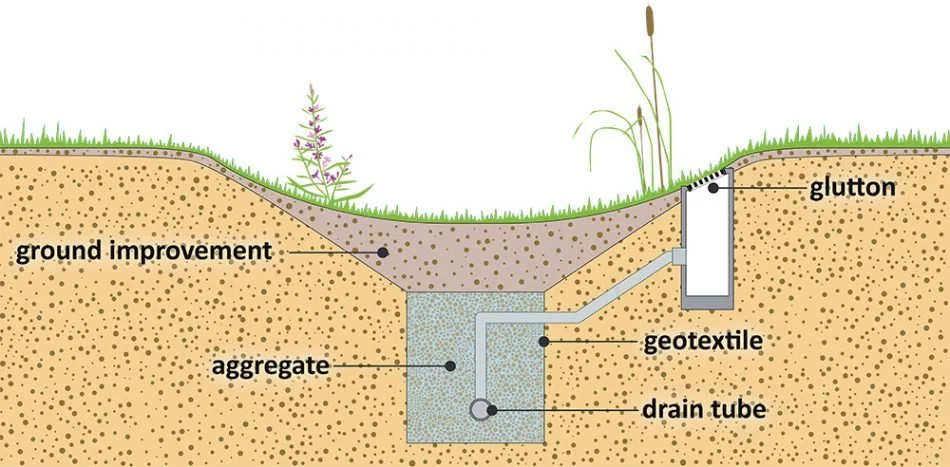BIOSWALES
Grass swales are vegetated shallow, gently sloped channels for stormwater conveyance and infiltration. They are one of the simplest and most effective Low Impact Design (LID) techniques for managing stormwater on both urban and rural sites. Instead of funneling runoff quickly into storm drains, grass swales use vegetation, soil, and natural infiltration to reduce runoff volume, remove pollutants, and promote groundwater recharge.
How Grass Swales Work
When it rains, water flows into the swale from adjacent surfaces:
Sediment and debris settle out due to reduced flow velocity.
Pollutants like oils, nutrients, and metals are filtered and absorbed by soil and plant roots.
Infiltration occurs through the soil, replenishing groundwater.
Cleaned water either infiltrates entirely or continues to a downstream system (like a bioretention basin, wetland, or detention pond).
Factors Influencing Cost
Installation: Includes site preparation, grading, the soil mix (often containing sand and compost), and the plants themselves.
Plants: Using native plants adapted to your climate can reduce maintenance costs for water, fertilizer, and mowing.
Soil: Specialized soil mixes are needed for proper drainage and filtration, adding to the overall cost.
Site complexity: The difficulty of the site, including existing infrastructure and topography, impacts installation costs.
Design and engineering: Professional services are needed for the design, engineering, and permitting process.
Bioswales approximately cost $5 to $25 per square foot for installation and can have a similar annual maintenance cost. The total price depends on factors like the site's complexity, the type and volume of native plants chosen, the specific soil mix required, and design and engineering fees. Long-term costs are often lower than traditional hard-piped stormwater systems.
SITE DESIGN
A well-functioning grass swale depends on thoughtful design:
Shape & Slope:
Typically trapezoidal or parabolic in cross-section.
Longitudinal slope between 1%–4% is ideal — steep enough for flow, but gentle enough for infiltration.
Maintain 5’ clearance from the bottom of the swale to the highest point of the groundwater table.
If the longitudinal slope exceeds 4%, utilize check dams, berms or weirs to create a step-down gradient. Limit the maximum ponding depth to 6–12 inches.
Vegetation:
Deep-rooted native grasses and sedges are best, as they tolerate both wet and dry conditions.
Vegetation should be dense enough to slow water and stabilize soil but not so tall that it impedes flow.
Soil:
Soils should be well-draining; sandy loams or amended soils are preferred.
Clay should not exceed 5%
Compacted soils should be loosened to improve infiltration.
Check Dams (optional):
Small rock or vegetated barriers across the swale slow flow further, increasing infiltration and reducing erosion.
Underdrain (optional):
In areas with poor infiltration or heavy rainfall, an underdrain can be added to prevent standing water.
If not properly designed, the disadvantages of bioswales include potential flooding during heavy storms, erosion if water flows too quickly, and high maintenance requirements to prevent issues like sediment buildup and clogged drains. They can also be costly to construct, may require significant space, and can attract pests if not properly maintained.
Maintenance
Mow or trim vegetation 2–3 times a year to maintain density and flow.
Inspect after storms for erosion, sediment buildup, or bare patches.
Remove litter and debris regularly.
Replant or reseed as needed with native species.
Operational
High maintenance: They require regular upkeep, including mowing, weeding, and debris removal, to function effectively.
Cost: Construction and maintenance costs can be higher than for conventional landscaping.
Pest attraction: Poorly maintained bioswales can become breeding grounds for pests, such as mosquitoes.
With proper maintenance, grass swales can last decades while continuing to provide ecological and hydrological benefits.
Some of the specific ways Mane Cultivation could use grass swales on our estate:
Direct runoff from roads or greenhouses toward bioretention areas.
Slow and spread water across sandy soils for better infiltration.
Establish vegetated corridors that connect microclimates and enhance the site’s ecological integrity.
Because the Big Sandy Basin has naturally sandy soils and gentle terrain, grass swales are an ideal, low-cost way to work with the landscape rather than against it—integrating water management, soil health, and native habitat into one simple system.
Frequently Asked Questions (FAQ)
Can I use a bioswale on any site?
A swale can be used on any site, but it may be more esthetic than a filtration system.
When should check dams and underdrains be used?
Fast moving water needs time to filtrate. Watch your location during rainstorms and assess the water flow across the site. Underdrains can be used to move water to another location if needing to collect more water after initial filtration has occurred.
Can swales be used with other LID designs?
Yes, multiple strategies can be used together for stormwater management based on individual site requirements.




